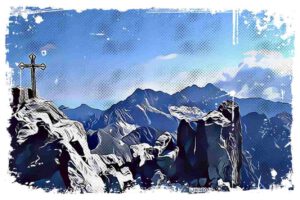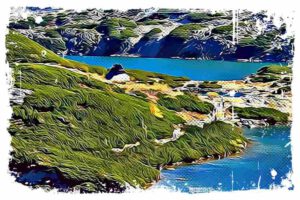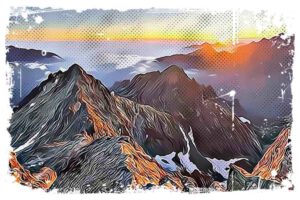You might think that with so many tourists exploring the trails, the Tatra Mountains’ secrets have all been revealed. But let me say, there’s so much more to discover in this southern edge of Poland than what you’d find in a typical tourist guide. I’ve compiled a list of some lesser-known amazing facts about the Tatra Mountains to surprise and delight you!

A Few Intriguing Facts to Start With
- Many people believe that the name „Tatras” likely originates from the Old Slavonic word „ter,” meaning a rock or cliff, or from the Galician „tertaro,” which refers to a hill.
- If you want to pitch a tent in the Slovak Tatras, there’s only one place to do it – at the camp in Polana pod Wysoka (Google Map Location). Just remember to report it in advance and pay the fee to the forester.
- The largest (not the highest) waterfall in the Tatras is Siklawa (approximately 70m), cascading from the threshold of the Valley of Five Polish Ponds.
- The highest waterfall in the Tatra Mountains is Ciezka Siklawa, standing at about 100m tall and located on the Slovak side.
- The largest lake in the entire Tatras is Morskie Oko, with an area of 34.54 hectares. The deepest, however, is Wielki Staw Polski, plunging 79.3 meters deep.
- The first recorded ascent of Rysy took place on July 30, 1840, by Eduard Blásy and his guide Ján Ruman Driečny the Elder.
- I can tell you that 10,000 years ago, glaciers graced the Tatra Mountains.
- The formation of the Tatra Mountains began a whopping 200 million years ago.
- I believe it’s worth mentioning that the highest peak located entirely in Poland is Kozi Wierch, reaching 2,291 meters.
- Lastly, the Staroleśna Valley boasts the largest number of lakes in the Tatras, with 27 of them! The Gąsienicowa Valley takes second place, home to 21 lakes.

The Tatra Mountains’ Lesser-Known Stories
Now that you’ve learned some fascinating facts about the Tatra Mountains, let’s dive deeper into a few lesser-known stories that make this region even more captivating!
1. The Deadly Halny Wind
Halny is a warm, dry, and gusty wind that blows from the peaks of the Tatra Mountains towards the valleys during spring and autumn. This wind is infamous for ripping off roofs, breaking trees, and having a huge impact on human well-being due to rapid changes in air pressure. It can cause insomnia, headaches, and even increase aggression and negative emotions.
Police statistics show that when the foehn (halny) wind blows, the number of fights, homicides, and suicides rises.
In May 1968, this wind reached a staggering speed of 288 kilometers per hour and was known to hurl stones larger than a fist!
↳ Before you head to Tatra Park, I highly recommend reading my complete guide to Tatra Mountains. I showcase the most scenic places you won't want to miss. Make sure to check it out, so you don't overlook anything interesting: Tatra Mountains – An Insider’s Guide to All Attractions and Info
2. The Republic of Zakopane
As World War I came to an end, the Austro-Hungarians started losing control over the Polish lands they had occupied. This included Zakopane and the surrounding areas. On October 13, 1918, the independent Republic of Zakopane was established at the foot of the Tatra Mountains, led by the writr Stefan Żeromski. This tiny republic only lasted for 35 days before being incorporated into the Second Republic of Poland.
3. Luxtorpeda – The Legendary Train
The Luxtorpeda (Lux-Torpedo) was a legendary diesel rail bus with aerodynamic shapes that broke speed records in the Second Poland’s Republic. Running between Krakow and Zakopane, it covered the distance in just 2 hours and 18 minutes! Today, that same train journey takes almost twice as long. Check this out below:

4. Tatra Races – A Love for Motorization
During the Second Polish Republic, from 1927 to 1931, international car races were held on the road from Łysa Polana to Włosienica. Hundreds of cars sped along the seven-kilometer route with 54 corners. It was during this time that the highlanders fell so deeply in love with motorization that they began naming their horses after famous car brands like Bugatti, Lancia, or Alfa Romeo.
5. Gold Mines in the Mountains

In the 15th century, gold mines operated on the southern slopes of Kryvan. These mines featured adits and stone buildings where miners lived. However, mining ceased at the end of the 18th century due to the depletion of the deposit. So, if you’re hiking the Krynów trail today, don’t count on finding a gold nugget along the way.
6. The Mysterious Uranium Tunnels

Gold wasn’t the only mineral sought after in the Tatras. If you take a walk around the Białego Valley, you’ll see barred entrances to two adits that were dug up in the 1950s. During that time, there was an intense arms race between the West and the Soviets.
I encourage you to read this article too: How Did Poland Change After World War II
The Soviet army hoped to find uranium in the Tatra Mountains, needed for the production of nuclear weapons. The Soviet army carried out the work and restricted access to the valley. However, they never found any uranium—or at least that’s the official version…
7. The Incredible View from the Tatra Mountains
It’s a myth that in exceptionally favorable weather, you can see the Baltic coast from the highest peaks of the Tatras. But what can you really see? Babia Góra (50 kilometers away) is a common sight, and less often Szyndzielnia (120 kilometers). The record achievement is usually considered to be when employees at the meteorological observatory on Kasprowy Wierchy saw the Sudeten Pradziad, 240 kilometers away.
For more information about stunning places in Tatras, check this: The Beauty of the Tatra Mountains – 20 Best Hiking Trails
8. The Mysterious Mountain Specter

The Brocken specter is an optical phenomenon where you see your own shadow on a cloud below you, enlarged and surrounded by a rainbow halo. It’s named after the Brocken peak in the Harz Mountains, where Johann Esaias Silberschlag first observed and described it in the 18th century. Climbers created a superstition that seeing a ghost is an omen of death in the mountains. However, if someone encounters this phenomenon three times, they’re said to be safe from harm in the mountains.
9. The Tatra Ski Jumps
There are currently five ski jumps under the Tatra Mountains, all located next to each other: Wielka Krokiew, Medium Krokiew, Little Krokiew, Little Krokiew, and the even smaller Adam, where children train. However, there used to be more Tatra ski jumps built in different places, such as Jaworzynka Valley, Polana Kalatówki, Wyżnia Kira Miętusia, the Valley of Five Polish Ponds, Kasprowy Wierch, and Hala Kondratowa. Only on the last facility could skiers fly up to fifty meters. The others were considered „children’s” hills by today’s standards.
10. The Unpopular Lenin Trail
In 1913, the future leader of Soviet Russia, Lenin, lived with his wife in Biały Dunajec. He was already active in politics, in contact with communists from various countries, and enjoyed hiking in the Tatra Mountains. In his memory, the Lenin Trail was created during the People’s Republic of Poland. The trail led from Kuźnice through Boczań, Hala Gąsienicowa, Zawrat, the Valley of Five Polish Ponds, and Morskie Oko. However, the name did not catch on and mountaineers and highlanders stubbornly destroyed the Leninist markings.
Did You Know That Chamois Favor the Slovak Side?
The Tatra chamois is one of the most recognizable symbols of the Tatra Mountains, found on both the Polish and Slovak sides. This elusive animal even graces the coat of arms of the Tatra National Park. However, chamois are an endangered species—just a few decades ago, their population was below 500.

Thankfully, efforts by naturalists over the years have significantly contributed to the gradual renewal of the chamois population. In 2017, there were 1,232 chamois in the Tatra Mountains—though this was slightly less than in previous years. It’s worth mentioning that Polish and Slovak mountaineers have been working together to monitor the Tatra chamois population since 1957.
Interestingly, even though animals don’t recognize borders and move freely between the two sides, the Slovak side seems to be the preferred habitat. In 2017, 746 chamois were counted in the Slovak Tatras, while only 296 were found on the Polish side. Similarly, bears living in the Tatras also favor the Slovak side, with around 30 bears calling it home.
Slovak Shelters and the Ingenuity of Porters
While Poland may have the edge in terms of technology, such as mechanized vehicles and freight lifts for servicing Tatra shelters, the Slovak side has a unique solution to supply their shelters. The Slovak shelters are typically located at higher altitudes, making it difficult for vehicles to reach them.
So, how do Slovak tourists get their food, and how are the shelters kept free from waste? The answer lies in the institution of the „porter”.These individuals manually deliver everything needed for the shelter’s functioning, walking along narrow trails with massive backpacks containing food, water, gas cylinders, and firewood.
After dropping off supplies at the shelter, porters collect waste and garbage left by tourists on their return trip. This system allows the Slovak shelters to function efficiently and accommodate hundreds of thousands of visitors each year.
Juliusz Słowacki – A Resting Place Controversy
Juliusz Słowacki, one of Poland’s national bards, was initially buried in Paris, at Montmartre Cemetery. However, few people know that his final resting place became the subject of a heated dispute among Polish intellectuals in the early 20th century.
The idea to bring the bard’s ashes back to Poland was born, and Marshal Józef Piłsudski himself was a major advocate for the plan. The goal was to have Słowacki’s remains interred in the basement of the Wawel Cathedral on the 100th anniversary of his birth in 1909. Before reaching a consensus on the final resting place, though, other ideas were considered.
One such proposal came from Stefan Żeromski, who suggested transferring Słowacki’s ashes to the crag of Kościelec in the Tatra Mountains. Eventually, an agreement was reached, and Słowacki’s remains were laid to rest next to Mickiewicz—with permission. So, if you’re a fan of Słowacki’s work, remember the story behind his final resting place and the passionate debate it inspired.
The Mystery of the Ice Pass
The Ice Pass in the Tatra Mountains is a place shrouded in great mystery, with stories surrounding it that could serve as the basis for a gripping crime movie. One of the most well-known tales involves the Kasznic family, who on August 3, 1925, stayed at the Teryego Shelter in the Valley of Five Spiskie Ponds.

The family had a long journey ahead of them to reach Zakopane, requiring them to traverse the Jaworowa Valley, make their way to Jaworzyna Spiska, and then overcome Łysa Polana. During the summer, this task isn’t particularly challenging for a physically capable tourist, but when the weather takes a turn for the worse, as it did then, the journey becomes perilous. The Kasznic family chose to return with four Polish mountaineers they encountered at the shelter.
What happened next remains an unsolved mystery to this day. As they descended the route to Zakopane, nearly all of them perished, but there was no apparent cause for their demise. The sole survivor, Waleria Kasznicowa, was discovered by the Head of the Tatra Emergency Service, General Mariusz Zaruski.
References:
- https://fajnepodroze.pl/10-ciekawostek-o-tatrach/
- https://pl.wikipedia.org/wiki/Tatry
- https://pl.wikipedia.org/wiki/Tatry_Zachodnie



